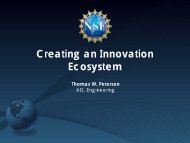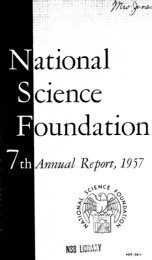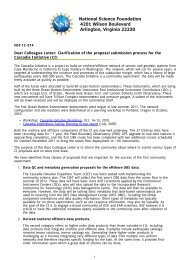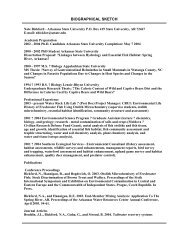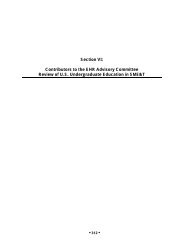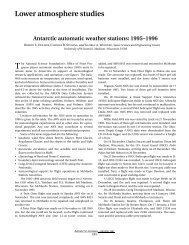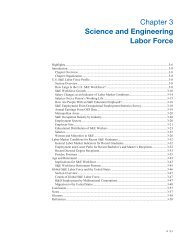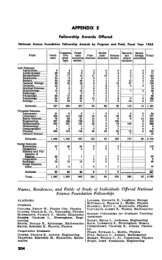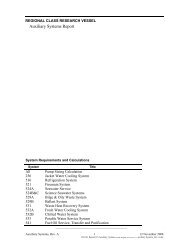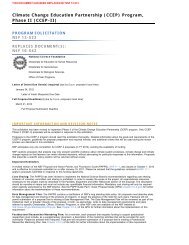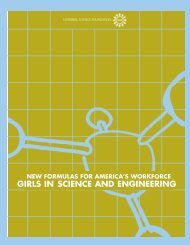Global Risk Governance of Nanotechnology (M.C. Roco)
Global Risk Governance of Nanotechnology (M.C. Roco)
Global Risk Governance of Nanotechnology (M.C. Roco)
Create successful ePaper yourself
Turn your PDF publications into a flip-book with our unique Google optimized e-Paper software.
F. Frankel - copyright<br />
<strong>Global</strong> <strong>Risk</strong> <strong>Governance</strong> <strong>of</strong> <strong>Nanotechnology</strong><br />
M.C. <strong>Roco</strong><br />
National Science Foundation,<br />
National <strong>Nanotechnology</strong> Initiative, and<br />
International <strong>Risk</strong> <strong>Governance</strong> Council<br />
Taipei, August 31, 2007
Topics<br />
� What is special about nanotechnology?<br />
� Possibilities for global governance<br />
� <strong>Risk</strong> governance <strong>of</strong> nanotechnology<br />
� Nano environmental research at NSF / NNI<br />
MC <strong>Roco</strong>, 8/31/05
Benchmark with experts in over 20 countries<br />
“Nanostructure Science and Technology”<br />
Book Springer, 1999<br />
<strong>Nanotechnology</strong><br />
is the control and restructuring <strong>of</strong> matter at<br />
dimensions <strong>of</strong> roughly 1 to 100 nanometers (from<br />
about 1 atom to about 100 molecular diameters),<br />
where new phenomena<br />
enable new applications<br />
M.C. <strong>Roco</strong>, 8/31/07
WHAT IS SPECIAL ABOUT NANOTECHNOLOGY ?<br />
� Reaches at the basic level <strong>of</strong> organization <strong>of</strong> atoms & molecules,<br />
where the fundamental properties/functions <strong>of</strong> manmade<br />
and living systems are defined and can be changed<br />
� Broad technology platform<br />
- for industry, biomedicine, environment<br />
Consequences<br />
� Has stimulated R&D in all developed countries and many<br />
countries in (R&D investments in over 65 countries)<br />
� Has stimulated the speed and scope <strong>of</strong> R&D that exceeds for now<br />
the capacity <strong>of</strong> regulators to assess human/ environmental impact
A specific framework is needed for<br />
risk governance <strong>of</strong> nanotechnology (IRGC)<br />
Focus on risk analysis for the higher-risk, high production<br />
applications:<br />
- Open and complex system<br />
- fundamental (high risk)<br />
- developments are not known (role organizations)<br />
- accelerated (upstream measures needed)<br />
- cross S,E&T (complex interactions)<br />
- With broad implications (general platform)<br />
- affects most areas <strong>of</strong> economic activity, effect <strong>of</strong><br />
the “food chain” <strong>of</strong> the nanotech products (need<br />
for comprehensive evaluation <strong>of</strong> societal implications)<br />
- global technological implications, cross-borders<br />
(connect models for governance at the national<br />
\and the international levels, E-W, N-S) MC. <strong>Roco</strong>, 8/31/07
<strong>Nanotechnology</strong><br />
New understanding,<br />
discoveries,<br />
and innovations<br />
support<br />
Growth<br />
- <strong>Nanotechnology</strong> R&D<br />
- Infrastructure: Physical,<br />
Human resources, Legal,<br />
Organizations<br />
- Regulatory measures<br />
and standards<br />
(Open system)<br />
Applications<br />
through<br />
Converging Technologies<br />
changes<br />
New Products<br />
Human Health and Cognition<br />
Societal System<br />
Policies, governance:<br />
Congress, WH, others<br />
<strong>Nanotechnology</strong> in Society<br />
J. Nanoparticle Research, 7(2), 2005<br />
implications on on<br />
Societal<br />
changes<br />
- Quality <strong>of</strong> <strong>of</strong> life, Access to to<br />
knowledge, Human dignity<br />
- Economic, EHS<br />
- Cultural, International<br />
M.C. <strong>Roco</strong>, 8/31/07
WORLDWIDE MARKET INCORPORATING NANOTECNOLOGY<br />
(Estimation made in 2000 after international study in > 20 countries)<br />
MARKET INCORPORATING<br />
10000<br />
NANOTECHNOLOGY ($B)<br />
1000<br />
100<br />
10<br />
1<br />
Annual rate <strong>of</strong> increase about 25%<br />
2000 2005 2010 2015 2020<br />
YEAR<br />
$1B products by 2015<br />
US: 80% public – know little/nothing about NT<br />
Active nanostructures<br />
NT in the main stream<br />
About 2M workers<br />
Systems <strong>of</strong> NS<br />
Passive nanostructures<br />
Rudimentary Complex<br />
Reference: <strong>Roco</strong> and Bainbridge, 2001<br />
Total $B<br />
Deutche Bank<br />
Lux Research<br />
Mith. Res. Inst.<br />
M.C. <strong>Roco</strong>, 8/31/07
Converging Technologies transforming tools (overview in 2000)<br />
where Nano and IT are integrators across all technology domains<br />
Cogno<br />
! (brain-behavior, .)<br />
! (neurotech, .)<br />
! (cultural, .)<br />
The “Push”<br />
Information Technology Research<br />
Info<br />
NBIC<br />
! (system approach, .)<br />
Nano<br />
The “Pull”<br />
Bio<br />
National <strong>Nanotechnology</strong> Initiative<br />
Reference: <strong>Roco</strong> and Bainbridge, 2003<br />
NIH Roadmaps<br />
NSF Biocomplexity<br />
USDA Roadmaps<br />
! (biotechnology, .)<br />
M.C. <strong>Roco</strong>, 8/31/07
TIMELINE IRGC <strong>Nanotechnology</strong> FOR BEGINNING Project OF INDUSTRIAL PROTOTYPING AND<br />
NANOTECHNOLOGY COMMERCIALISATION:<br />
FOUR GENERATIONS OF PRODUCTS AND PRODUCTION PROCESSES<br />
~ 2000<br />
8/31/07 ESTABLISHING THE IRGC<br />
1 st : Passive nanostructures (1st generation products)<br />
a. Dispersed and contact nanostructures. Ex: aerosols, colloids<br />
b. Products incorporating nanostructures. Ex: coatings; nanoparticle<br />
reinforced composites; nanostructured metals, polymers, ceramics<br />
~ 2005<br />
Reference: <strong>Roco</strong>, 2004<br />
2 nd : Active nanostructures<br />
a. Bio-active, health effects. Ex: targeted drugs, biodevices<br />
b. Physico-chemical active. Ex: 3D transistors, amplifiers,<br />
actuators, adaptive structures<br />
CMU<br />
~ 2010<br />
3 rd : Systems <strong>of</strong> nanosystems<br />
Ex: guided assembling; 3D networking and new<br />
hierarchical architectures, robotics, evolutionary<br />
~ 2015- 2015<br />
2020<br />
4 th : Molecular nanosystems<br />
Ex: molecular devices ‘by design’,<br />
atomic design, emerging functions<br />
Frame 1<br />
<strong>Risk</strong> <strong>Governance</strong> Frame 2<br />
M.C. <strong>Roco</strong>
18000<br />
16000<br />
14000<br />
12000<br />
10000<br />
8000<br />
6000<br />
4000<br />
2000<br />
0<br />
Nano publications per year<br />
1990 - 2006<br />
USA<br />
Japan<br />
China<br />
Germany<br />
1990 1991 1992 1993 1994 1995 1996 1997 1998 1999 2000 2001 2002 2003 2004 2005 2006<br />
Courtesy: Georgia Tech TPAC / CNS-ASU Analysis <strong>of</strong> SCI Publication<br />
Over half <strong>of</strong><br />
highly cited papers<br />
Fastest growing group in world percentage: China, Korea, Taiwan<br />
MC <strong>Roco</strong>, 8/31/07
NSE patents at USPTO by country group<br />
Assignee country group analysis by year, 1976-2006 (“title-claims” search)<br />
Number <strong>of</strong> patents<br />
1600<br />
1400<br />
1200<br />
1000<br />
800<br />
600<br />
400<br />
200<br />
0<br />
USPTO Country Groups (Title-claims search, 1976-2006)<br />
United States<br />
Japan<br />
European Group<br />
Others<br />
1976<br />
1977<br />
1978<br />
1979<br />
1980<br />
1981<br />
1982<br />
1983<br />
1984<br />
1985<br />
1986<br />
1987<br />
1988<br />
1989<br />
1990<br />
1991<br />
1992<br />
1993<br />
1994<br />
1995<br />
1996<br />
1997<br />
1998<br />
1999<br />
2000<br />
2001<br />
2002<br />
2003<br />
2004<br />
2005<br />
2006<br />
2006 ranking : U.S., Japan, Korea, Germany, Taiwan<br />
Year<br />
United European<br />
Year States Japan Group Others<br />
1976 30 3 3 6<br />
1977 53 2 3 3<br />
1978 58 3 9 3<br />
1979 26 2 7 3<br />
1980 50 3 9 0<br />
1981 61 1 10 3<br />
1982 51 1 13 1<br />
1983 73 1 15 4<br />
1984 93 4 8 0<br />
1985 97 2 16 1<br />
1986 100 6 11 1<br />
1987 132 12 11 0<br />
1988 124 10 10 6<br />
1989 162 21 28 4<br />
1990 164 17 28 7<br />
1991 204 14 28 9<br />
1992 256 31 26 19<br />
1993 244 36 20 18<br />
1994 227 51 28 10<br />
1995 302 57 33 36<br />
1996 325 52 40 27<br />
1997 393 62 73 25<br />
1998 486 65 103 56<br />
1999 548 75 96 85<br />
2000 612 81 122 68<br />
2001 818 84 147 112<br />
2002 926 102 168 144<br />
2003 1103 143 182 207<br />
2004 1300 172 203 257<br />
2005 1155 160 198 245<br />
2006 1488 212 214 298<br />
Total 11661 1485 1862 1658<br />
NSF, ASU
Context – <strong>Nanotechnology</strong> in the World<br />
National government investments 1997-2006 1997<br />
millions $ / year<br />
5000<br />
4500<br />
4000<br />
3500<br />
3000<br />
2500<br />
2000<br />
1500<br />
1000<br />
500<br />
0<br />
Seed funding<br />
(1991 - )<br />
1997<br />
1998<br />
W. Europe<br />
Japan<br />
USA<br />
Others<br />
Total<br />
1999<br />
2000<br />
NNI Preparation<br />
(vision / benchmark)<br />
2001<br />
2002<br />
2003<br />
2004<br />
2005<br />
1 st Strategic Plan<br />
(passive nanostructures)<br />
2006<br />
2007<br />
2006 (est. NSF)<br />
Country /<br />
Region<br />
2008<br />
Gov.<br />
Nanotech<br />
R&D, 2005<br />
($M)<br />
2009<br />
2010<br />
2 nd Strategic Plan<br />
(active ns. & systems)<br />
Specific<br />
Nanotech<br />
R&D, 2005<br />
($/Capita)<br />
USA 1200 4.0<br />
EU-25 ~1050 2.3<br />
Japan ~ 950 7.4<br />
China ~ 250 0.2<br />
Korea ~ 300 6.2<br />
Taiwan ~ 110 4.7<br />
Industry R&D ($6B) has exceeded national government R&D ($4.6B) in 2006<br />
J. Nanoparticle Research, 7(6), 2005, MC. <strong>Roco</strong>
NSF-NSE Award / Paper / Patent Percentage<br />
Keyword search for nanotechnology contents: NSF<br />
awards, USPTO patents and ISO papers<br />
20%<br />
19%<br />
18%<br />
17%<br />
16%<br />
15%<br />
14%<br />
13%<br />
12%<br />
11%<br />
10%<br />
9%<br />
8%<br />
7%<br />
6%<br />
5%<br />
4%<br />
3%<br />
2%<br />
1%<br />
0%<br />
Percentage <strong>of</strong> NSE Awards/Patents/Papers<br />
Top 20 Journals' Nano Paper Percentage<br />
3 Selected Journals' Nano Paper Percentage<br />
Title-claim Search's Nano Patent Percentage<br />
NSF Nano New Award Percentage<br />
1990 1991 1992 1993 1994 1995 1996 1997 1998 1999 2000 2001 2002 2003 2004 2005 2006 2007<br />
Year<br />
MC <strong>Roco</strong>, 8/31/07
What is <strong>Governance</strong>?<br />
� “<strong>Governance</strong>” – a versalite term <strong>of</strong> widespread use<br />
� Definition: <strong>Governance</strong> refers to processes, conventions<br />
and institutions that determine:<br />
- How power is exercised in the view <strong>of</strong> managing resources<br />
and interests;<br />
- How important decisions are made and conflicts resolved; and<br />
- How various stakeholders are accorded participation.<br />
� General principles <strong>of</strong> “good governance” include e.g.:<br />
- Transparency;<br />
- Responsibility, accountability; and<br />
- Participation.<br />
� Core principles + experience with NNI, ITR, BioCom….<br />
to be applied to global nanotechnology governance<br />
M.C. <strong>Roco</strong>, 8/31/07
NT <strong>Governance</strong> and <strong>Risk</strong> <strong>Governance</strong><br />
2000-2020<br />
NT<br />
GOVERNANCE<br />
- Investment policy<br />
- Science policy<br />
- <strong>Risk</strong> governance<br />
-Others<br />
Four key functions<br />
SCOPE<br />
- Conceptual framework<br />
for integrated approach<br />
for decision-makers<br />
- Neutral, constructive<br />
platform for all actors<br />
NANOTECHNOLOGY<br />
RISK<br />
GOVERNANCE (IRGC)<br />
GOALS<br />
- Deficits & recommend.<br />
- Cross stakeholders<br />
- Multiple authorities<br />
- Cross-boundary, global<br />
- Short & Long-term view<br />
WHAT IS DIFFERENT<br />
- Structure NT development:<br />
4 generations; 2 frames<br />
- Include social context in<br />
assessment (ELSI + )<br />
- <strong>Governance</strong> approach:<br />
corrective and adaptive<br />
RISK GOVERNANCE APPROACH<br />
- Begin with the IRGC framework<br />
- Methodologies for 2 risk frames<br />
- Focus: EHS, ELSI, EGI, PSI, HDI<br />
- Stakeholder engagement<br />
- <strong>Risk</strong> communication<br />
- <strong>Risk</strong> governance methods<br />
M.C. <strong>Roco</strong>, 8/31/07
NANOTECHNOLOGY GOVERNANCE OVERVIEW<br />
2000-2020<br />
Core <strong>Governance</strong> Process:<br />
Long-term view, transforming,<br />
inclusive, horizontal/vertical, priority<br />
in education, addressing societal<br />
dimensions, NT risk governance<br />
Main Actors:<br />
R&D Organizations<br />
(Academe, industry, gov.)<br />
Implementation Network<br />
(Regulators, business,<br />
NGOs, media, public)<br />
Social Climate<br />
(Perceived authority <strong>of</strong><br />
science, civil involvement)<br />
National Political Context<br />
International Interactions<br />
M.C. <strong>Roco</strong>, 8/31/07
Possibilities for a <strong>Global</strong> <strong>Governance</strong> <strong>of</strong> <strong>Nanotechnology</strong><br />
General approach<br />
- Facilitate and provide reference models<br />
to the global self - regulating ecosystem:<br />
- open source models <strong>of</strong> NT development and its institutions,<br />
discovery, innovation, education, human resource, informatics<br />
- emerging and converging technology infrastructure;<br />
- use economical incentives for accelerating NT production;<br />
- foster suitable international organizations and agreements<br />
- Focus on bottom-up and lateral interactions<br />
and less on top - down measures<br />
- using political leadership and democratic principles,<br />
- social consensus in knowledge based societies<br />
- System <strong>of</strong> global communication and participation in all<br />
phases <strong>of</strong> governance, facilitated by international organizations<br />
M.C. <strong>Roco</strong>, 8/31/07
Foster suitable international organizations<br />
Ex: International standards organizations working on nanotechnology<br />
ASME International<br />
NNCO, M.C. <strong>Roco</strong>, 8/31/07
Foster suitable international organizations<br />
Ex: OECD Working Party on <strong>Nanotechnology</strong><br />
Working Party on <strong>Nanotechnology</strong> held its first meeting in<br />
Leuven, Belgium, on 8-9 May 2007, and decided to establish<br />
steering groups for 6 potential projects, to implement in 2007<br />
and 2008:<br />
A. Statistics and Measurement<br />
B. Impacts and Business Environment<br />
C. International Research Collaboration<br />
D. Outreach and public engagement<br />
E. Dialogue on Policy Strategies<br />
F. Contribution <strong>of</strong> Nanotech to <strong>Global</strong> Challenges<br />
M.C. <strong>Roco</strong>, 8/31/07
<strong>Governance</strong> <strong>of</strong> nanotechnology development:<br />
four main functions<br />
� Transformative<br />
investment policy, S&T policy, support innovation & informatics,<br />
prepare pipeline in education, facilitate commercialization;<br />
use NBIC integration tools<br />
� Responsible development<br />
EHS, ELSI+, methods for risk governance, effective oversight,<br />
communication & participation (incl. public), voluntary measures<br />
� Inclusive, collaborative<br />
Building national capacity; multi-sector partnerships;<br />
international capacity, leveraging, and research strategy<br />
� Visionary<br />
Long-term and global view in planning & investment,<br />
setting priorities, human development/progress<br />
Reference: “<strong>Governance</strong> <strong>of</strong> Converging Technologies Integrated from the Nanoscale”,<br />
MC <strong>Roco</strong>, Annals New York Academy <strong>of</strong> Sciences, Vol. 1093 (2006), pp. 1-23 M.C. <strong>Roco</strong>, 8/31/07
The call for innovation: United States (2004-2007)<br />
� Three reports on innovation (2004-2005):<br />
� “Engineering Research and America’s Future:<br />
Meeting the Challenges <strong>of</strong> a <strong>Global</strong> Economy”<br />
(National Academy <strong>of</strong> Engineering)<br />
� “Innovate American” (Council <strong>of</strong> Competitiveness)<br />
� “Rising Above the Gathering Storm”<br />
(National Research Council)<br />
� Presidential Decree:<br />
“American Competitiveness Initiative” (2005)<br />
Congressional Act:<br />
“US National Competitiveness Act” (2006, 2007)<br />
National Academies<br />
recommendations are<br />
realized in ACI.<br />
M.C. <strong>Roco</strong>, 8/31/07
Possibilities for a <strong>Global</strong> <strong>Governance</strong> <strong>of</strong> <strong>Nanotechnology</strong><br />
Transformative function<br />
- Support tool development, knowledge creation, innovation and<br />
informatics, and commercialization for nanotechnology, in the<br />
international context;<br />
- Creating better opportunities for development <strong>of</strong> nanotechnology<br />
in developing countries;<br />
- Allocation <strong>of</strong> development funds for common topics:<br />
nomenclature, metrology, standards, patent evaluation,<br />
databases, and EHS methodologies including for a predictive<br />
toxicology approach for nanomaterials;<br />
- Use “incentives” and “empowering stakeholders”<br />
in the open and global ecosystem<br />
M.C. <strong>Roco</strong>, 8/31/07
Responsible development<br />
Multi-level structure <strong>of</strong> risk governance<br />
Implication Domain / Examples <strong>of</strong> RG activities / Implementation approach<br />
International<br />
(Frames 1 and 2)<br />
Societal<br />
(Frames 1 and 2)<br />
Technological<br />
system<br />
(Frames 1 and 2)<br />
System<br />
component<br />
(Frames 1)<br />
Ex.: Int.<br />
dialogue<br />
Ex.: (in US) NT Law<br />
and WH NNI priority<br />
Ex.: Specific legislation<br />
for hybrid nano-bio systems<br />
International agreements, partnerships,<br />
Steering groups, communication links<br />
Corrective, adaptive approach<br />
Ex.: Treating new nanostructures as new chemical;<br />
Fundamental research/communication for new knowledge<br />
National R&D, policies and laws<br />
Institutional capacity building<br />
Adaptive management approach<br />
Consider R&D programs<br />
new regulations<br />
and organizations<br />
Adapting existing<br />
regulations and<br />
organizations<br />
Reference: International <strong>Risk</strong> <strong>Governance</strong> Council, http://www.irgc.org/irgc/projects/nanotechnology/<br />
M.C. <strong>Roco</strong>, 8/31/07
Possibilities for a <strong>Global</strong> <strong>Governance</strong> <strong>of</strong> <strong>Nanotechnology</strong><br />
Responsible development function<br />
- Development with priority <strong>of</strong> general benefit applications<br />
such as increasing productivity and sustainable<br />
nanomanufacturing; Applying nanotechnology for<br />
improving availability <strong>of</strong> common Earth resources such as<br />
water, food, energy, and sustainable clean environment<br />
- Voluntary measures and science-based decision for risk<br />
management<br />
- Public inclusion and participation in international<br />
activities<br />
- Develop organizational capacity for effective oversight<br />
M.C. <strong>Roco</strong>, 8/31/07
NIH<br />
NIST<br />
NASA<br />
DOD<br />
DOE<br />
NSF<br />
2001: Six<br />
Agencies<br />
Inclusive: Inclusive:<br />
industry, academe, government,<br />
non-government non government and international organizations,<br />
communication institutions, public at large.<br />
DOTr<br />
DOT<br />
EPA<br />
EX: S&T agencies participants in the<br />
National <strong>Nanotechnology</strong> Initiative<br />
DOS<br />
IC<br />
USDA<br />
DOJ<br />
2002: Seven<br />
New Agencies<br />
FDA<br />
NRC<br />
DHS<br />
DOC<br />
TA<br />
2003-4: Four<br />
New Agencies<br />
USDA<br />
FS<br />
DOC<br />
BIS<br />
USPTO<br />
ITC<br />
CPSC<br />
NIOSH<br />
2005: Six New<br />
Agencies<br />
USGS<br />
DOL<br />
DOEd<br />
2006: Three<br />
New Agencies<br />
M.C. <strong>Roco</strong>, 8/31/07
Survey Investments<br />
Current Norms<br />
Ex.: International Dialogue<br />
on Responsible <strong>Nanotechnology</strong> R&D<br />
Recommended measures<br />
International<br />
Dialogue<br />
26 countries<br />
June 2004, Virginia<br />
Joint Statement<br />
Immediate Actions<br />
http://www.nsf.gov/home/crssprgm/nano/dialog.htm<br />
First: June 2004, Virginia, USA<br />
Second: June 2006, Japan<br />
Third: Brussels, EC<br />
M.C. <strong>Roco</strong>, 8/31/07
Possibilities for a <strong>Global</strong> <strong>Governance</strong> <strong>of</strong> <strong>Nanotechnology</strong><br />
Inclusiveness and partnership function<br />
- Supporting partnerships between various<br />
stakeholders active in nanotechnology<br />
applications and related emerging technologies;<br />
- <strong>Global</strong> communication and information, including for<br />
coordinated risk research strategies;<br />
- Involving international organizations to advance<br />
multi stakeholder global challenges;<br />
- Encourage international and cross-sector interactions<br />
M.C. <strong>Roco</strong>, 8/31/07
Possibilities for a <strong>Global</strong> <strong>Governance</strong> <strong>of</strong> <strong>Nanotechnology</strong><br />
Commitment to long-term view<br />
- Detecting earlier signs <strong>of</strong> change using international<br />
expert groups; adopt real time technology assessment<br />
- Commitment to long-term planning and priority setting<br />
using global scenarios and anticipatory measures on<br />
nanotechnology development<br />
- Integrate nanotechnology development with other<br />
emerging and converging technologies; Conduct<br />
research specific for future generations <strong>of</strong><br />
nanotechnology products (Frame 2, IRGC)<br />
- Evaluate the trends for exponential growth <strong>of</strong> nanoscale<br />
knowledge and technology capabilities<br />
M.C. <strong>Roco</strong>, 8/31/07
Five possibilities<br />
for global nanotechnology governance<br />
1. Establish models for the global self-regulating ecosystem<br />
to enhance discovery, education, innovation,<br />
nanoinformatics and commercialization<br />
2. Create and leverage S&T nanotech platforms for new<br />
products in areas <strong>of</strong> highest societal interest<br />
3. Develop NT for common resources and EHS requirements<br />
4. Support global communication and international<br />
partnerships<br />
5. Commitment to long-term, priority driven, global view<br />
using scenarios and anticipatory measures<br />
M.C. <strong>Roco</strong>, 8/31/07
Responsible development context:<br />
SPECIFIC RISKS INDUCED BY EMERGING TECHNOLOGIES<br />
� Increased technology complexity and uncertainty in<br />
comparison with traditional technologies<br />
� Interdependency with wide ranging effects throughout our<br />
industrial and social systems, including convergence and<br />
integration trends<br />
� Increased importance <strong>of</strong> societal implications which may<br />
not be known at the release <strong>of</strong> the technology. Importance<br />
<strong>of</strong> reducing the time delay between development <strong>of</strong><br />
scientific knowledge and evaluation <strong>of</strong> societal implications<br />
M.C. <strong>Roco</strong>, 8/31/07
<strong>Nanotechnology</strong> risk governance issues<br />
EHS, ELSI, Education Gap, Human Development, Political and Security<br />
� Investment policies (R&D, infrastructure) for best and equitable outcomes<br />
in society<br />
� Occupational safety<br />
� Consumer safety<br />
� Environmental safety<br />
� Legal framework (science testimony, new cases; at national<br />
and international levels) and its impact on international trade<br />
� Individual rights to information and knowledge<br />
� Social implications: human integrity and dignity; new opportunities<br />
and losses; societal structure; etc.)<br />
� International relationships: IP, North-South divide, equity between<br />
haves and have-nots<br />
� Long-term human development – need for anticipatory measures<br />
� Need for principles to be converted to defined and planned actions<br />
MC <strong>Roco</strong>, 8/31/07
Sources <strong>of</strong> risks and the governance approach<br />
Various dimensions: EHS, ELSI,<br />
Education Gap, Human Development Issues, Political and Security Issues<br />
Natural<br />
Technological<br />
Social<br />
Causal on single events<br />
(current practice)<br />
<strong>Risk</strong> <strong>Governance</strong><br />
Dynamic<br />
interactions<br />
Societal<br />
System<br />
Adaptive, corrective measures<br />
on system (proposed)<br />
ENVIRONMENT<br />
HEALTH<br />
SAFETY<br />
J. Nanoparticle<br />
Research, 2005, 7(2-3)<br />
MC. <strong>Roco</strong>, 06/06/06
SURVEY ON NANOTECHNOLOGY GOVERNANCE<br />
www.irgc.org/nanotechnology (M.C. <strong>Roco</strong> and E. Litten)<br />
• Part A: The Role <strong>of</strong> Government<br />
Responders: 11 countries on nanotechnology governance; and 26 countries and EU on<br />
their nanotechnology R&D programs; December 2005 (146 pages, on the web)<br />
• Part B. The Role <strong>of</strong> Industry<br />
Responders: Industrial Technology Research Institute (Chinese Taipei), Allianz and<br />
NanoBioNet (Germany), Ayanda Biosystems and Swiss Re (Switzerland), Chair <strong>of</strong><br />
the International Organization for Standardization Technical Committee 229 on<br />
Nanotechnologies (UK), Canon, Environ, Intel, NanoDynamics Inc. and Pfizer (US)<br />
• Part C. The Role <strong>of</strong> <strong>Risk</strong> Research Organizations<br />
Responders: Ochanomizu University (Japan), Institute for Occupational Health Sciences<br />
(IST) (Switzerland), Centre for <strong>Nanotechnology</strong> in Society (University <strong>of</strong> California,<br />
US); Center for Science Technology and Public Policy (University <strong>of</strong> Minnesota, US);<br />
Woodrow Wilson International Center for Scholars (US)<br />
• Part D. The Role <strong>of</strong> NGOs<br />
Responders: ETC Group (Canada), Demos, The Forum for the Future, Greenpeace (UK),<br />
the Center for Responsible <strong>Nanotechnology</strong>, Environmental Defence, Foresight<br />
Nanotech Institute, the National Resources Defence Council and Sciencecorps (US).<br />
M.C. <strong>Roco</strong>, 8/31/07
IRGC Survey on <strong>Nanotechnology</strong> <strong>Governance</strong><br />
Areas <strong>of</strong> relevance in governance (December 2005)<br />
Stakeholder EHS ELSI Education<br />
Gap<br />
A.<br />
Government<br />
B.<br />
Industry<br />
C. R&D risk<br />
organizations<br />
D.<br />
NGOs<br />
Political<br />
and<br />
Security<br />
Human<br />
Develop.<br />
2 1 - - -<br />
2 - 1 - -<br />
2 1 - - -<br />
2 1+ - - -<br />
Summary: 8 3 1 0 0<br />
M.C. <strong>Roco</strong>, 8/31/07
Characteristics <strong>of</strong> a risk governance framework<br />
(IRGC <strong>Nanotechnology</strong> Policy Paper, 2007)<br />
� Adaptive, valuing flexibility in the application <strong>of</strong> risk management<br />
strategies as knowledge and understanding <strong>of</strong> the field develops<br />
� Collaborative, sharing information, skills and expertise internationally<br />
among different agencies and stakeholders<br />
� <strong>Global</strong>, proposing international minimal “level playing field” guidelines<br />
and reference models to generate confidence in safety management<br />
in a globalized economy<br />
� Realistic and Fast, recognizing that such a dynamic field calls for<br />
active and ongoing learning, rather than an “after the fact” approach,<br />
including building on emerging experience <strong>of</strong> those new technologies<br />
� Responsive to essential human values, such as equity, respect <strong>of</strong><br />
ethics, safety, equal opportunities and right to privacy<br />
M.C. <strong>Roco</strong>, 8/31/07
Include IRGC approach to the governance <strong>of</strong> risks<br />
- Adds a pre-assessment phase that includes ‘problem framing’,<br />
‘early warning’, and ‘organisation <strong>of</strong> the risk governance process’;<br />
- Considers the assessment <strong>of</strong> societal concerns alongside<br />
conventional risk assessment (in order to allow the scientific<br />
consideration <strong>of</strong> stakeholder and public concerns by risk managers<br />
in the process <strong>of</strong> generating the knowledge required for risk<br />
evaluation and management);<br />
- Provides for a risk evaluation and management process that<br />
includes the concerns, interests and values <strong>of</strong> stakeholders<br />
through different participative procedures; and<br />
- Considers risk communication as an integral part <strong>of</strong> all stages <strong>of</strong><br />
the risk governance process and vital for effectively linking the<br />
different components.<br />
M.C. <strong>Roco</strong>, 8/31/07
IRGC <strong>Nanotechnology</strong> Project IRGC RISK GOVERNANCE FRAMEWORK FOR NT:<br />
Strategies as a function <strong>of</strong> the NT generation (Frames 1 & 2)<br />
Management Sphere:<br />
Decision on & Implementation <strong>of</strong> Actions<br />
To be defined before most<br />
nanoproducts are known<br />
<strong>Risk</strong> <strong>Risk</strong> Management Management<br />
Implementation<br />
• Option Realisation<br />
• Monitoring & Control<br />
• Feedback from <strong>Risk</strong> Mgmt. Practice<br />
Decision Making<br />
• Option Identification & Generation<br />
• Option Assessment<br />
• Option Evaluation & Selection<br />
Pre-Assessment: Pre-Assessment<br />
• Problem Framing<br />
• Early Warning<br />
• Screening<br />
• Determination <strong>of</strong> Scientific Conventions<br />
Tolerability & Acceptability Judgement<br />
<strong>Risk</strong> Evaluation<br />
• Judging the Tolerability<br />
& Acceptability<br />
• Need for <strong>Risk</strong><br />
Reduction Measures<br />
Two frames for NT<br />
Communication<br />
Multidimensional in<br />
nanotechnology<br />
<strong>Risk</strong> Characterisation<br />
• <strong>Risk</strong> Pr<strong>of</strong>ile<br />
• Judgement <strong>of</strong> the<br />
Seriousness <strong>of</strong> <strong>Risk</strong><br />
• Conclusions & <strong>Risk</strong><br />
Reduction Options<br />
Assessment Sphere:<br />
Generation <strong>of</strong> Knowledge<br />
Knowledge development is<br />
critical for nanotechnology<br />
<strong>Risk</strong> Appraisal: <strong>Risk</strong> Appraisal<br />
<strong>Risk</strong> Assessment<br />
• Hazard Identification & Estimation<br />
• Exposure & Vulnerability Assessment<br />
• <strong>Risk</strong> Estimation<br />
Concern Assessment<br />
• <strong>Risk</strong> Perceptions<br />
• Social Concerns<br />
• Socio-Economic Impacts<br />
Specific to 4 nanoproduct generations Applied to specific NT areas<br />
Specific to natural, manufactured and bi-products NS<br />
07-08-29 ESTABLISHING THE IRGC M.C. <strong>Roco</strong>, . 8/31/07<br />
37 ⏐ x
Strategies as a function <strong>of</strong> the generation <strong>of</strong> nanotechnology:<br />
Application to Frame 1 and Frame 2 (pre-assessment)<br />
Increased<br />
� Complexity,<br />
� Knowledge needs<br />
� Implications<br />
Nanosystems<br />
Active<br />
nanostructures<br />
Passive<br />
nanostructures<br />
Frame 2 longer term<br />
Unknown<br />
(Higher ambiguity in society)<br />
Frame 2 shorter term<br />
Technological System<br />
Uncertainty<br />
Frame 1<br />
Component Complexity<br />
R&D underway<br />
Regulatory measures considered<br />
NT application areas<br />
J. Nanoparticle Research, 2006, Vol. 8(2)<br />
Strategy escalator<br />
Future work on social<br />
and global dimensions<br />
(focus on ELSI + )<br />
Broader “strategy”, design<br />
and recommendations are<br />
needed (focus on EHS, ELSI)<br />
Some specific problems,<br />
with a focus on regulators<br />
(focus on EHS)<br />
M.C. <strong>Roco</strong>, 8/31/07
The <strong>Risk</strong><br />
Management<br />
Escalator and<br />
Stakeholder<br />
Involvement<br />
(from Simple<br />
via Complex<br />
and Uncertain<br />
to Ambiguous<br />
Phenomena) with<br />
reference to<br />
nanotechnology<br />
M.C. <strong>Roco</strong>, 8/31/07
<strong>Risk</strong> governance <strong>of</strong> nanotechnology:<br />
priority actions by stakeholders (1)<br />
• Agree global nomenclature and standard approach to<br />
characterisation <strong>of</strong> nano realm<br />
• Establish occupational and consumer safety guidelines based<br />
on particle and other material behaviour at the nanoscale<br />
• Communication and information: between stakeholders to<br />
facilitate governance at regional/ national/ international levels<br />
• Voluntary systems: Initial collection and organisation <strong>of</strong> data<br />
from industry to establish good practice guidelines. Initial<br />
activities to advance voluntary systems in the U.K. and U.S.<br />
have already begun in 2006<br />
Reference: <strong>Roco</strong> and Renn, IRGC, 2006 and 2007<br />
M.C. <strong>Roco</strong>, 8/31/07
<strong>Risk</strong> governance <strong>of</strong> nanotechnology:<br />
priority actions by stakeholders (2)<br />
• Review applicability <strong>of</strong> existing regulation in analogous fields to<br />
speed up implementation<br />
• Investment in risk related research for developing a metrology for<br />
characterising and sensing nanostructures and a predictive<br />
toxicology approach<br />
• Research for Frame Two including development <strong>of</strong> scenarios,<br />
infrastructure models and systems for earlier detection <strong>of</strong> major<br />
changes<br />
• Assessment and extension <strong>of</strong> existing and new models for public<br />
involvement<br />
M.C. <strong>Roco</strong>, 8/31/07
Societal Implications: Follow-up<br />
<strong>of</strong> the September 2000 report<br />
• Make support for social, ethical, and<br />
economic research studies a priority:<br />
(a) New theme in the NSF program solicitations;<br />
(b) Centers with societal implications programs;<br />
(c) Initiative on the impact <strong>of</strong> technology, NBIC, HSD<br />
• NNCO – communicate with the public<br />
and address Environmental, Health and<br />
and Safety issues, and unexpected consequences<br />
http://nano.gov<br />
• NSET’s Nanostructures Environmental and Health Issues<br />
working group has been established in 8/2003, 12 agencies<br />
• Workshop with EC (2001); Links to Europe, Americas, Asia;<br />
International Dialogue (26 countries, NSF-sponsored)<br />
MC <strong>Roco</strong>,8/31/07
Key issues in long term (2000 - )<br />
• Respect human right to: access to knowledge and<br />
welfare; human integrity, dignity, health and safety<br />
• Balanced and equitable R&D nanotechnology investment<br />
• Environment protection and improvement (water, air, soil)<br />
Sustainable development, life-cycle <strong>of</strong> products, global<br />
effects (weather), eliminate pollution at the source<br />
• Economic, legal, ethical, moral, regulatory, social and<br />
international (developed-developing countries) aspects<br />
Interacting with the public and organizations<br />
• Adaptive/corrective approach for a complex system<br />
Immediate and continuing issues:<br />
- EHS in research laboratories and industrial units<br />
- Harmonizing nomenclatures, norms and standards<br />
- Primary data and methodology for risk analysis<br />
MC. <strong>Roco</strong>, 8/31/07
NNI activities<br />
for Environmental, Health and other Societal Implications<br />
A. Align R&D investment with societal implications<br />
B. Evaluate and implement regulatory standards<br />
C. Coordinated measures for EHS and ELES<br />
D. Periodical meeting for grantees,<br />
setting research targets, and<br />
interaction with industry and the public<br />
E. International collaboration (International Dialog<br />
for Responsible R&D <strong>of</strong> <strong>Nanotechnology</strong>)<br />
Reference: <strong>Roco</strong>, Environmental S&T, 2005<br />
MC. <strong>Roco</strong>, 8/31/07
November 2006<br />
NYAS December 2006<br />
November 2006
FY 2008 U.S. National <strong>Nanotechnology</strong> Initiative<br />
Budget Request - $1,445 million<br />
Average rate <strong>of</strong> increase since 2000: over 30% per year<br />
using bottom-up project based approach<br />
Fiscal Year NNI<br />
2000 $270M<br />
2001 $464M<br />
2002 $697M<br />
2003 $862M<br />
2004 $989M<br />
*2005 $1,200M<br />
*2006 $1,303M<br />
2007 $1,392M<br />
R 2008 $1,445M<br />
* Includes Congressionally<br />
directed additional funding<br />
February 5, 2007<br />
1600<br />
1400<br />
1200<br />
1000<br />
800<br />
600<br />
400<br />
200<br />
0<br />
2000 2002 2004 2006 2008<br />
Request<br />
NNI ($ million)<br />
MC <strong>Roco</strong>, 8/31/07
NSET established NEHI Working Group in Oct. 2003<br />
- PURPOSE -<br />
• Exchange <strong>of</strong> information among agencies<br />
• Facilitate the identification, prioritization, and<br />
implementation <strong>of</strong> research and other activities<br />
• Promote communication <strong>of</strong> information related to<br />
research on environmental and health<br />
implications <strong>of</strong> nanotechnology<br />
NEHI = “Nanomaterials Environmental and Health Implications”<br />
MC <strong>Roco</strong>, 8/31/07
Recent NEHI activities<br />
www.nano.gov<br />
• “EHS Research Needs for Engineered Nanoscale Materials”<br />
(September 2006)<br />
• “Prioritization <strong>of</strong> EHS Research Needs for Engineered<br />
Nanoscale Materials” (August 2007, released for public<br />
comment)<br />
• Current NNI EHS research portfolio (est. Fall 2007)<br />
• Gaps analysis and strategy to address EHS research priorities<br />
and opportunities for interagency collaboration (est. Fall 2007)<br />
• Process for periodic review <strong>of</strong> progress and research priorities<br />
MC <strong>Roco</strong>, 8/31/07
NSF – discovery, innovation and education<br />
in Nanoscale Science and Engineering (NSE)<br />
www.nsf.gov/nano , www.nano.gov<br />
FY 2008 Request: $390M ~1/4 <strong>of</strong> Federal and ~1/12 <strong>of</strong> World Investment<br />
– Fundamental research - seven PCAs with new priorities<br />
– Establishing the infrastructure - over 3,000 active projects;<br />
24 large centers, 2 user facilities (NNIN, NCN), multidisciplinary teams<br />
– Training and education – over 10,000 students and teachers/yr<br />
Fiscal Year NSF<br />
2000 $97M<br />
2001 $150M<br />
2002 $199M<br />
2003 $221M<br />
2004 $254M<br />
2005 $338M<br />
2006 $344M<br />
2007 $373M<br />
R 2008 $390M<br />
400<br />
350<br />
300<br />
250<br />
200<br />
150<br />
100<br />
50<br />
0<br />
2000 2002 2004 2006 2008<br />
NSE ($M)<br />
MC <strong>Roco</strong>, 8/31/07
NSF Overview on nano ENV (1)<br />
� “Upstream” research and education since 2000;<br />
2000 – nanoparticles and other passive nanostructures<br />
2003 – nanomanufacturing safety; NISE, NCLT, NSEC<br />
2006 – added focus on the 2 nd -3 rd generations<br />
2010 – to focus on nanosystems (more complex, dynamic)<br />
� Main topics funded in 2006 in the EHS NNI cross-cut<br />
(a) instrumentation, metrology, and analytical methods;<br />
(b) effects on biological systems and human health;<br />
(c) effects on the environment;<br />
(d) monitoring methods for health / env. surveillance; and<br />
(e) risk assessment and management methods.<br />
M.C. <strong>Roco</strong>, 8/31/07
Fluorexcent Nanotube Sensors for Measuring<br />
Toxic Chemicals Inside <strong>of</strong> Living Cells<br />
M. Strano, UIUC
SIZE is EVERYTHING<br />
Fate and Impacts <strong>of</strong> Manufactured Carbonaceous<br />
Nanomaterials in the Environment<br />
Size and “stickiness” determine fate in air, water, and soil.<br />
Preparation Resulting size distribution<br />
Stirring in organic<br />
solvent<br />
Stirring in pure<br />
water<br />
Stirring in water<br />
with citrate<br />
Aerosolized fr<br />
om pure water<br />
Single peak at 200 nm<br />
Small peak at 30 nm, large<br />
peak at 100 nm<br />
Primary particles <strong>of</strong> 10 nm,<br />
aggregated<br />
Single peak at 40 nm<br />
Small Particle<br />
25x35 nm<br />
10 nm<br />
50 nm<br />
Aging <strong>of</strong> airborne nanoparticles by ozone affects their<br />
stickiness to soil in water<br />
Large Particle<br />
125x300 nm<br />
Linsey C. Marr, Peter J. Vikesland, Harry C. Dorn, Virginia Tech
NSF Overview on nano ENV (2)<br />
� Societal Dimensions in FYs 2007 estimate & 2008 request:<br />
2007: $59.0 million (69%) <strong>of</strong> all NNI - $85.9 million<br />
2008: $62.9 million (65%) <strong>of</strong> all NNI - $97.5 million<br />
� EHS: NSF dedicates about 7% <strong>of</strong> its NNI budget for<br />
projects with a primary focus on fundamental aspects <strong>of</strong><br />
environmental implications and applications <strong>of</strong><br />
nanomaterials:<br />
2007: $25.7 million (6.9%) <strong>of</strong> the total NSF/NNI estimate<br />
2008: $28.8 million (7.4%) <strong>of</strong> the total NSF/NNI request<br />
� These topics are supported through all NSF programs<br />
M.C. <strong>Roco</strong>, 8/31/07
Investm ent (m illion $/yr)<br />
$70.00<br />
$60.00<br />
$50.00<br />
$40.00<br />
$30.00<br />
$20.00<br />
$10.00<br />
$0.00<br />
NSF Investment in Societal Dimensions <strong>of</strong> NT<br />
Of FY 2008 NNI/NSF request <strong>of</strong> $390 M, $63 M or 16.1% is for SI,<br />
and $28.8 M (7.4%) for nano EHS<br />
FY 2001 FY 2002 FY 2003 FY 2004 FY 2005 FY 2006 FY 2007<br />
(est.)<br />
Environmental, Health, and Safety Formal and Informal Education<br />
Ethical, Legal, and Social Issues Percentage Societal Dimensions<br />
FY 2008<br />
Request<br />
18.00<br />
16.00<br />
14.00<br />
12.00<br />
10.00<br />
8.00<br />
6.00<br />
4.00<br />
2.00<br />
0.00<br />
Percentage<br />
M.C. <strong>Roco</strong>, 8/31/07
Closing remarks<br />
� Seeds for global nanotechnology governance including risk<br />
governance have been created, and there are opportunities for a<br />
systemic approach in several areas - such as for innovation,<br />
nanoinformatics, standards and EHS knowledge development<br />
Needs in global governance:<br />
- coordinated policies and investments where cultural and<br />
ideological / economical differences are important;<br />
- nanotechnology applications for sustainable Earth resources<br />
Needs in global risk governance:<br />
- coordinated research, methodologies and oversight mechanisms;<br />
- addressing future generations <strong>of</strong> nanoproducts<br />
� Increased global interactions are needed for immediate risk<br />
governance implementation and longer-term research goals M.C. <strong>Roco</strong>, 8/31/07
Several Background References<br />
� "Societal Implications <strong>of</strong> Nanoscience and <strong>Nanotechnology</strong>",<br />
Kluwer, now Springer (<strong>Roco</strong> and Bainbridge, 2001)<br />
� “Coherence and Divergence <strong>of</strong> Megatrends in S&E” ,<br />
Proc. Swiss Academies, 2000; and J. Nanoparticle Research, Vol. 4 (<strong>Roco</strong>, 2002)<br />
� “<strong>Nanotechnology</strong>–Unifying and transforming tools”, AIChE J. (<strong>Roco</strong>, 2004)<br />
� “Environmentally Responsible Development <strong>of</strong> <strong>Nanotechnology</strong>”,<br />
Environmental Science and Technology (<strong>Roco</strong>, 2005)<br />
� “<strong>Nanotechnology</strong>’s Future”, Scientific American, August 2006, (<strong>Roco</strong>, 2006)<br />
� “<strong>Nanotechnology</strong>: Societal Implications - Maximizing Benefits for<br />
Humanity”, 2 vols., Springer (<strong>Roco</strong> and Bainbridge, 2005)<br />
� “The NNI: Past, Present and Future”, in Handbook on Nanoscience, Engineering<br />
and Technology, CRC, Taylor and Francis, (<strong>Roco</strong>, 2007)<br />
� “<strong>Nanotechnology</strong> <strong>Risk</strong> <strong>Governance</strong>” (<strong>Roco</strong> and Renn, 2007), in book <strong>Global</strong> <strong>Risk</strong><br />
<strong>Governance</strong>: Applying and Testing the IRGC Framework, Renn and Walker (eds.), Springer<br />
� “Possibilities for <strong>Global</strong> <strong>Governance</strong> <strong>of</strong> Converging Technologies”,<br />
J. Nanoparticle Res. (<strong>Roco</strong>, 2007)



